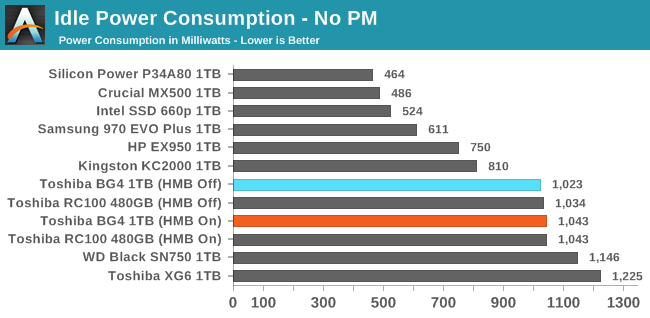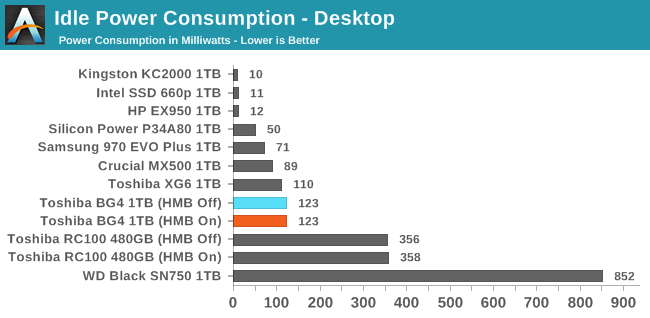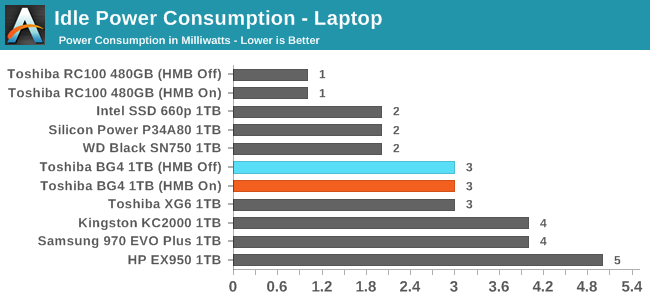The Toshiba/Kioxia BG4 1TB SSD Review: A Look At Your Next Laptop's SSD
by Billy Tallis on October 18, 2019 11:30 AM ESTPower Management Features
Real-world client storage workloads leave SSDs idle most of the time, so the active power measurements presented earlier in this review only account for a small part of what determines a drive's suitability for battery-powered use. Especially under light use, the power efficiency of a SSD is determined mostly be how well it can save power when idle.
For many NVMe SSDs, the closely related matter of thermal management can also be important. M.2 SSDs can concentrate a lot of power in a very small space. They may also be used in locations with high ambient temperatures and poor cooling, such as tucked under a GPU on a desktop motherboard, or in a poorly-ventilated notebook.
| Toshiba BG4 1TB NVMe Power and Thermal Management Features |
|||
| Firmware | AEJA0102 | ||
| NVMe Version |
Feature | Status | |
| 1.0 | Number of operational (active) power states | 3 | |
| 1.1 | Number of non-operational (idle) power states | 2 | |
| Autonomous Power State Transition (APST) | Supported | ||
| 1.2 | Warning Temperature | 82 °C | |
| Critical Temperature | 86 °C | ||
| 1.3 | Host Controlled Thermal Management | Supported | |
| Non-Operational Power State Permissive Mode | Not Supported | ||
The Toshiba/Kioxia BG4 offers a fairly typical set of power management features. The warning and critical temperature thresholds are rather close to each other, but are both high enough for the battery-powered consumer devices this drive is intended for. The non-operational power state permissive mode feature isn't included—hardly any drives do so far, but it is a feature intended specifically for the product segment targeted by the BG series.
The active power states provided by the BG4 offer a decent range of power limits, and the idle states promise a good balance of power savings and low transition latency.
| Toshiba BG4 1TB NVMe Power States |
|||||
| Firmware | AEJA0102 | ||||
| Power State |
Maximum Power |
Active/Idle | Entry Latency |
Exit Latency |
|
| PS 0 | 3.7 W | Active | - | - | |
| PS 1 | 2.6 W | Active | - | - | |
| PS 2 | 2.2 W | Active | - | - | |
| PS 3 | 50 mW | Idle | 0.8 ms | 1.2 ms | |
| PS 4 | 5 mW | Idle | 3 ms | 32 ms | |
Note that the above tables reflect only the information provided by the drive to the OS. The power and latency numbers are often very conservative estimates, but they are what the OS uses to determine which idle states to use and how long to wait before dropping to a deeper idle state.
Idle Power Measurement
SATA SSDs are tested with SATA link power management disabled to measure their active idle power draw, and with it enabled for the deeper idle power consumption score and the idle wake-up latency test. Our testbed, like any ordinary desktop system, cannot trigger the deepest DevSleep idle state.
Idle power management for NVMe SSDs is far more complicated than for SATA SSDs. NVMe SSDs can support several different idle power states, and through the Autonomous Power State Transition (APST) feature the operating system can set a drive's policy for when to drop down to a lower power state. There is typically a tradeoff in that lower-power states take longer to enter and wake up from, so the choice about what power states to use may differ for desktop and notebooks, and depending on which NVMe driver is in use. Additionally, there are multiple degrees of PCIe link power savings possible through Active State Power Management (APSM).
We report three idle power measurements. Active idle is representative of a typical desktop, where none of the advanced PCIe link or NVMe power saving features are enabled and the drive is immediately ready to process new commands. Our Desktop Idle number represents what can usually be expected from a desktop system that is configured to enable SATA link power management, PCIe ASPM and NVMe APST, but where the lowest PCIe L1.2 link power states are not available. The Laptop Idle number represents the maximum power savings possible with all the NVMe and PCIe power management features in use—usually the default for a battery-powered system but rarely achievable on a desktop even after changing BIOS and OS settings. Since we don't have a way to enable SATA DevSleep on any of our testbeds, SATA drives are omitted from the Laptop Idle charts.
Note: Earlier this year we upgraded our power measurement equipment and switched to measuring idle power on our Coffee Lake desktop, our first SSD testbed to have fully-functional PCIe power management. The below measurements are all from the new equipment, and are not a perfect match for the older measurements in our previous reviews and the Bench database.



Active idle and desktop idle for the BG4 are both a bit on the high side, but there's no problem with the deepest idle power states. Since this is an OEM-only drive, it's safe to assume that all battery-powered systems using the BG4 will have fully-functional PCIe power management, so the desktop idle state will only be used for a short period of time before the drive drops down to the deeper idle state.

The idle wake-up latencies measured with the BG4 are comfortably below the limits promised by the drive, and are quicker than most other NVMe SSDs. The BG4 allows for aggressive power savings without sacrificing much responsiveness.










31 Comments
View All Comments
intelati - Friday, October 18, 2019 - link
That last image is absolutely ridiculous. You get good performing 1TB of SSD storage on a postage stand.Jesus H Christ.
MaxUserName - Friday, October 18, 2019 - link
No, BG4 have too poor performance:https://www.storagereview.com/toshiba_bg4_nvme_ssd...
Ratman6161 - Friday, October 18, 2019 - link
I took a quick look at your link but quit looking when I saw they were testing SQL Server as one of their tests and with 15,000 virtual users. Completely useless use case. Even if you are are a software developer running a local copy of SQL Server, you won't be testing 15K users. So its performance somewhat pales in comparison to many full size m.2 SSD's. There are trade-offs to every component and in a laptop, particularly a thin and light laptop, those trade-offs usually have to favor saving space and power efficiency. It accomplishes those two goals on its own plus the smaller size may enable a larger battery in some systems. so what if your 2 TB 970 Evo outperforms it. The people buying the systems where this would be used won't care. It seems pretty ideally suited to its target audience.Tams80 - Friday, October 18, 2019 - link
I second that being a silly review.This is, as the article here states multiple times, for space-constrained devices. The BG4 more than meets the needs of these. As a bonus to us as customers, it means manufacturers are less likely to solder down the SSDs, so we can actually replace/upgrade them.
0ldman79 - Wednesday, November 13, 2019 - link
We're looking at a review right now.It's not as fast as NVME but it's faster than SATA on most benchmarks.
It's a quarter size of most NVME drives.
svan1971 - Saturday, October 19, 2019 - link
Lord, learn how to spell stamp, amen.wenart - Sunday, October 20, 2019 - link
Does Jesus have a second name?Jambe - Thursday, October 24, 2019 - link
Hieronymus, obviously.ToTTenTranz - Friday, October 18, 2019 - link
The Smach-Z uses a 2230 M.2 NVMe slot.Just saying.
Kishoreshack - Friday, October 18, 2019 - link
Excellent reviewdeep dive into the ssd we will get in our laptops
I just hope these form factors become common
&
are adopted for every laptop